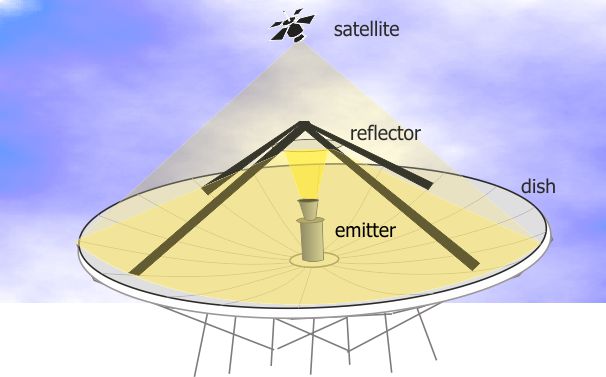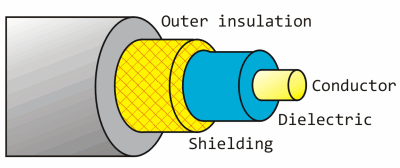Freesat reception - all about dishes
 Brian Butterworth published on UK Free TV
Brian Butterworth published on UK Free TV Satellite reception has both advantages and disadvantages compare with terrestrial (aerial) reception.
By using much higher frequencies (gigahertz, compared to terrestrial televisions megahertz) more transmission channels called transponders (the satellite equivalent of multiplexes) can be provided. For example, there are only six Freeview multiplexes, but Sky or Freesat users can access two hundred satellite transponders.
Aside from exceptional weather conditions (very heavy rain for example) digital satellite provides stable pictures and audio. Where Freeview transmitters are no more than 732 metres above sea level, the geostationary satellites used for television are 35,800,000 metres above the equator so reception is possible even where buildings, trees and hills make terrestrial reception impossible.

The downside of the transmitters being 22,300 miles up in the air is that the signals are very, very weak - so standard TV aerial is of little use. When the signals are sent to the satellites, huge dish transmitters are used to uplink the signal to the satellite. These are tens of metres from side to side, and feature an emitter that generates the signal, which is first bounced of a mirror (called a reflector) and then off the surface of the parabolic dish.

There are many satellites in the sky over the equator. Often these are in clusters over a particular position, for example there are four used for UK television are at 28.2 degrees east. There is another cluster over the 19.2 degrees east positions that are used for German television.
To receive these very weak signals from the satellite, it is necessary to use a dish for reception too. By using a reflective dish, this concentrates the signals onto a small device called a LNB. This is held in front of the dish by a metal arm.

The size of dish for reception is typically much smaller; often 60cm to 100cm in diameter, but the exact size depends upon the transmitting satellite transponder. To keep the transmission power levels down to levels that can be powered by the satellite's solar panels, each beam is focused on a particular area of the Earth's surface. If you are trying to receive the signal at the centre of this zone, a small dish is required. At the outer edges, you may need a 5 metre dish. Maps of these zones are provided by the satellite companies, and are called satellite footprints.
When the dish is installed it must be aligned carefully as the signal is very weak. The installer needs to know the inclination and the azimuth from the ground location to the satellite. If you install yourself you will find that there are markings on the dish that are used to point the dish in the correct position. It is important that the view of the satellite will not be blocked, so must take into account leaves growing on trees and potential building works.
For many people the LNB will have a single cable connected to it, however if you have Sky+ or a multi-room installation the LNB package will actually contain four receivers a quad-LNB. Unlike terrestrial television where you can split the aerial cable to feed more than one Freeview box or television set, with satelite reception you cannot. So, a Sky+ box with two receivers (so you can watch one thing and record another) has two cables connecting the box to the dish.
The cable that connects the dish to the receiver must be satellite grade cable. Whilst this looks superficially like the cable used to connect and aerial to a television, a higher grade cable is required for satellite reception.
Here is an image of a co-axial cable. This sort of cable is used to connect any type of receiving aerial to the reception equipment.

RG6, PF100 and PH100 are all types of coax cable that are suitable for the very weak signals that are received by a satellite dish. (The power is the same as you would receive from a one-bar electric heater on the moon).
The conductor in the centre passes the signals received from the dish to the set-top box. This is made from steel in RG6 cable, and from copper in the RF100 and PH100 types. This makes RG6 less suitable in the UK where rain can damage the cable.
The shielding is responsible for keeping unwanted external interference from damaging the signal. In the cheaper cable this will be a foil wrap, in better specified cables this is a braid (or mesh) of copper wires. The sheild in the RF100 covers 58% of the cable.
The non-conducting layer between the shield and the conductor is called the dielectric. This can be either a solid (RG6), foam (RF100) or air-spaced (PH100) dielectric. This makes the cables progressively more flexible (ie bendy without damage).
8:50 PM
Matt You'll need a satellite receiver as well as the dish and it would be better to go for a free to air type rather than a freesat box as you won't need the freesat software. I'd go for an HD box because several of the German channels transmit HD free to air now and for that you'd need an HDMI cable to connect to the TV
| link to this comment |
8:57 PM
Gordon I would have thought that a bigger dish would be easier to align because the stronger signal would give you more margin for error. I have a fairly large 1.2 metre dish & I fitted a bracket with 3 extra LNBs to receive signals from other satellites and it surprised me how easy it was to position the LNBs to get a good signal from each.
| link to this comment |
9:36 PM
Gordon Brockley: Speaking in general terms smaller dishes are more critical to align by the fact that they aren't gathering up that much of a signal to start off with, this meaning that the slightest movement past the ideal spot will cause the signal to drop down again under the sat receivers minimum level for reception, this resulting in the classic "no signal" warning being seen.
On the other hand large dishes are capable of gathering up more of the signal and with this being why the signal strength levels seen on sat boxes with larger dishes are always that much higher to that on a box using a standard mini-dish, a knock on effect of this higher level signal making these type of dishes "slightly" (and only) easier to align.
The reason for this being, that if the dish is being swept across from one side to the other then once a signal of a sufficiently high enough level to produce a picture is found it will be held for much longer before dipping down again on the other side, in other words by them having a slightly flatter response in the pick up zone to that experienced with small dishes and their almost razor sharp responses, the smaller the dish the worse it gets.
Of course the higher signal levels associated with larger dishes is why heavy thundery type downpours do not have the same effect on satellite reception in the way they do with smaller dishes, basically because the signal has further to drop before reaching the receivers lower threshold cut off level.
The secret of success when aligning satellite dishes is really by adopting slow motion movements.
| link to this comment |
4:48 PM
Two questions:
1. Is it possibe for a competent DIYer to realign a sat. dish?
2. Are suppliers of satellite equipment legally bound to give the purchaser the password to reset the system, etc.?
I bought three Freesat systems three years ago and had them fitted by a local firm. They have never been satisfactory. I can only get a few TV channels and even fewer radio channels.
My sat. boxes have a 'signal strength' and 'signal quality' page and the channels that come as 'no signal' have correspondingly low quality and strength readings. I've had the firm back to sort it out twice - once for free, but the second time for £35.00. I asked for the passwords and was told they were put in, but patently, they do not work - I can't access the boxes. I think they have witheld the passwords deliberately, fobbing me off with technical jargon, thus forcing me to pay them to come and sort out any problems.
can you help, please?
| link to this comment |
5:16 PM
Peterpiano: I dont quite understand where passwords come into the equation, as satellite boxes whether Freesat or Sky do not have such a thing, although Freesat boxes do require a post code to be entered during the initial set up procedure or after any subsequent resetting of the box, although the post code is only required to enable the viewer to have the correct regional news services.
Does your dish face into a tree or any other building or structure? because thats about the only thing that can cause problems with satellite reception other than the dish being misaligned.
Further advice dependant on reply.
| link to this comment |
5:19 PM
Peterpiano: Also meant to request if you could mention the model numbers of the Freesat boxes in question.
| link to this comment |
6:33 PM
Peterpiano: On having a rethink about your question regarding passwords, and although Freesat boxes generally do not request this I do appreciate that whatever you are using must request it be entered otherwise you wouldn't ask, and so should this apply then I would try the standard default of 0000 or 1234, although if either of these do not work then there is always the possibility that your installer has changed it, that is should the box allow this to be done, but though if you can provide the model numbers of the models involved this can be checked.
| link to this comment |
7:37 PM
Peterpiano Just to add that my old free to air satellite receivers do require passwords to enter the menu system to do retunes, add or delete channels etc. so if that is the case with yours I can't see how the original suppliers could possibly justify withholding the passwords. As JB38 says try 0000 or 1234 to start with. Also just out of interest did they fit a quad LNB and run 3 separate cables - one to each receiver - or have they tried to use some form of splitter?
| link to this comment |
1:11 PM
I .live in france and get good freeview with my sky system
But get a no sygnsl when I connect myDVB-T MINI BOX
And a data base empty sygn
Thanks for any advice
LES PUGH
| link to this comment |
Leslie Pugh: "DVB-T" stands for "Digital Video Broadcasting Terrestrial"; If it is satellite you are using then you probably require DVB-S (Digital Video Broadcasting Satellite).
Freeview is the brand name of terrestrial system in the UK and its Crown Dependancies.
The "free-to-air" channels are those which you're referring to, I think.
| link to this comment |